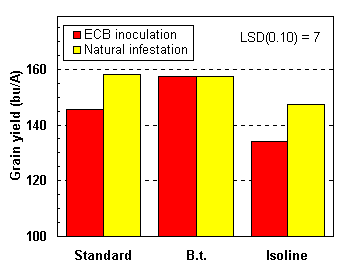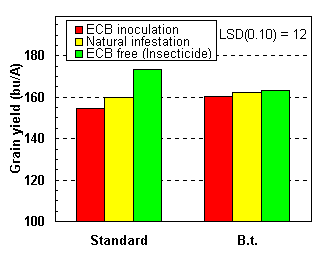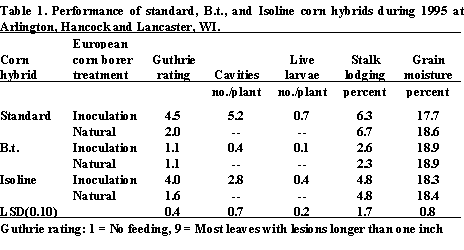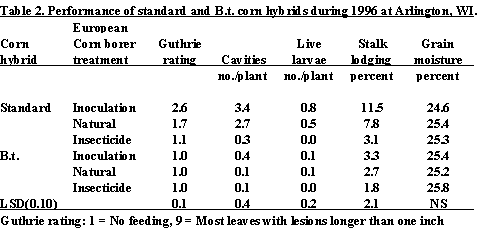February, 1997
Field Crops 28.31-10
Fighting European Corn Borer with B.t. Corn
Joe Lauer and John Wedberg
European corn borer, Ostrinia nubilalis (Hubner), is a major pest of corn
in North America. It was introduced into the United States from Europe about 1915
in shipments of infested corn to Massachusetts, New York, and Ontario, and has since
spread across the U.S. Yield losses of 2-7 percent for each borer on a plant can
result from feeding at various stages of plant growth. Corn yield reduction from
European corn borer is estimated to exceed $50 million in Illinois and $1 billion
in the U.S. annually. Feeding results in physiological disruption of the plant leading
to lower plant yield as well as physical lodging and ear drop of the plants.
European corn borer can survive the winter as full-grown larvae in weeds or corn
stalks. In Wisconsin, they pupate in May and the moths begin flying in early June.
These moths lay eggs on the underside of corn leaves which give rise to "first-generation"
larvae. First-generation larvae hatch in late June and lay a "second-generation"
of eggs which hatch by early-August.
Effective use of insecticides to control European corn borer requires scouting and
a knowledge of treatment thresholds. Applications should be immediate and a relatively
narrow application window exists. Many insecticides are currently registered for
European corn borer control. A new tool in our "arsenal" of weapons for
fighting European corn borer is B.t. corn.
What is B.t.?
B.t. is an abbreviation for the bacteria, Bacillus thuringiensis, which is found
in the soil. B.t. forms a crystal protein that is toxic to caterpillars (lepidopterans),
beetles (e.g. corn rootworm and Colorado potato beetle), and aquatic flies (e.g.
black flies and mosquitoes). After B.t. is eaten by the insect, the crystal dissolves
to release a toxin that attacks the gut lining. Feeding stops within a few hours.
The insect gut wall breaks down within 24 hours. Bacterial spores germinate and
invade the body cavity of the insect. The insect dies from toxins attacking the
gut wall, by a general body infection (septicemia) which is present within 48 hours,
and food deprivation. Over 70 different toxins are formed from B.t. crystal proteins.
The activity of the toxin in an insect depends on gut pH, the presence of enzymes
and reducing agents, and the presence of binding sites on cell membranes.
Using B.t. products to control European corn borer
The first use of B.t. products against European corn borer occurred in Europe in
1929. Currently, many commercial formulations of B.t. products are registered. B.t.
products are effective against first-generation European corn borer, because the
larvae concentrate in the leaf whorl of the corn plant and the product is easy to
apply. B.t. products are safe not only for applicators and detasslers, but also
birds, amphibians, fish and aquatic invertebrates. Most beneficial insects are not
affected by applications aimed at European corn borer. Use of B.t. products requires
early detection and scouting and prompt treatment is critical. B.t. activity is
relatively short with UV light and rainfall posing the biggest challenge to persistence.
B.t. products perform poorly against second-generation larvae and are generally
not labeled for use.
Using B.t. corn to control European corn borer
In 1993, Ciba-Geigy reported successful B.t. transformation of elite corn hybrids
using the "gene gun." Nearly every seed company has substantial efforts
underway to incorporate genes into elite corn hybrids. Incorporation of the B.t.
toxin into a corn plant overcomes many difficulties associated with insecticides
and B.t. products. B.t. corn offers season long protection against all generations
of European corn borer. B.t. corn offers potential for cross protection against
other caterpillar pests attacking corn such as sod webworm, cutworms, hop vine borer,
stalk borer, armyworm and corn earworm. Insecticide applications are eliminated
which also eliminates scouting costs and toxicity potential to non-target species
due to drift, poor timing, and availability of applicator or product.
B.t. corn evaluation in Wisconsin
Our objectives were to compare B.t. corn hybrids with adapted high performing non-B.t.
hybrids, and to evaluate B.t. corn performance under economically significant European
corn borer infestation.
During 1995, experiments were established near Arlington, Hancock, and Lancaster,
WI. Plots were 10 feet by 25 feet. Typical cultural practices used by farmers in
the surrounding area were used for plot establishment. Plots were planted on 15
May, 11 May and 17 May and harvested on 18 October, 16 October, and 14 October for
Arlington, Hancock, and Lancaster, respectively. The experimental design was four
replications of a randomized complete block in a split-split plot arrangement. Main
plots were hybrid. Three groups of hybrids were evaluated: 1) hybrids with the B.t.
gene included Northrup King 1032BT, Northrup King 1033BT, Ciba 1134E, Ciba 3206E
and Ciba 3208E; 2) closely related "isolines" that did not have the B.t.
gene included Northrup King 397, Northrup King 777, Ciba 1134X, Ciba 3206X and Ciba
3208X; and 3) standard hybrids that have performed well at these locations included
DeKalb DK512 and Golden Harvest H2387. Split-plots were two European corn borer
treatments: natural infestation and inoculation.

During 1996, the experiment was established at Arlington, WI. The experimental design
was four replications of a randomized complete block in a split-plot arrangement.
Main plots were standard and B.t. hybrids including: Ciba 1401E, Ciba 1402E, Ciba
4410E, Ciba MAX101, Ciba MAX21, Ciba MAX23, Ciba MAX357, Ciba MAX454, Ciba MAX747,
Ciba MAX88, Dairyland 1407, DeKalb DK493, Golden Harvest H2411, Northrup King 4734CBR,
Northrup King X4334CBR, and Pioneer 3769. Split-plots were the European corn borer
infestation levels of inoculation, natural infestation, and European corn borer
"free" where the insecticide "Pounce" was sprayed on July 3,
August 21, and September 3.
First- and second-generation European corn borer inoculations were performed by
infesting each plant in the two harvested rows. Approximately 100 egg masses on
waxed paper were placed on each plant at V7, V9, VT and R1. In 1996, second-generation
inoculation at VT and R1 was achieved by using a "bazooka" which delivers
egg masses mixed with corn grits to the leaf collar areas above the ear.
Description of test environments
The corn production year of 1995 saw two events which had an impact on corn yields
at all three locations. During the middle of July extremely high temperatures were
observed throughout most of Wisconsin. This may have interfered with pollination,
especially in areas that did not receive moisture until later in the season. Secondly,
a severe second-generation European corn borer infestation occurred throughout the
state. In 1996, a severe first-generation European corn borer infestation was seen
throughout the state.
Comparison of B.t. with standard corn hybrids

Averaged across all the 1995 locations, grain yields of the standard hybrids yielded
158 bushels per acre (Figure 1). When the standard hybrids were inoculated with
European corn borer four times during the season, grain yields decreased to 146
bushels per acre. B.t. corn hybrids, whether inoculated with European corn borer
or not, yielded similarly to the naturally infested standard corn hybrids. Yield
of isoline hybrids was 147 bushels per acre when under natural infestation and 134
bushels per acre when inoculated. At each location, the inoculation of European
corn borer in the plots decreased grain yields 11 bushels per acre at Arlington,
20 bushels per acre at Hancock. Lancaster grain yield was not affected by inoculation.
Agronomically, there was less stalk damage and lodging with the B.t. hybrids compared
to the standard and isoline hybrids (Table 1). Averaged across all the 1995 locations,
grain yields of the standard hybrids yielded 158 bushels per acre (Figure 1). When
the standard hybrids were inoculated with European corn borer four times during
the season, grain yields decreased to 146 bushels per acre. B.t. corn hybrids, whether
inoculated with European corn borer or not, yielded similarly to the naturally infested
standard corn hybrids. Yield of isoline hybrids was 147 bushels per acre when under
natural infestation and 134 bushels per acre when inoculated. At each location,
the inoculation of European corn borer in the plots decreased grain yields 11 bushels
per acre at Arlington, 20 bushels per acre at Hancock. Lancaster grain yield was
not affected by inoculation. Agronomically, there was less stalk damage and lodging
with the B.t. hybrids compared to the standard and isoline hybrids (Table 1).

Based on the three locations of data and the European corn borer pressure expressed
during 1995, B.t. corn hybrids performed similarly to adapted high performing hybrids.
This was observed at both Hancock and Arlington, while at Lancaster it appears that
other problems, i.e. pollination problems may have affected results. Since there
was greater than normal European corn borer pressure during 1995 and there was no
treatment where European corn borers were completely controlled by insecticides
throughout the season, we do not know how the standard and isoline hybrids might
have performed in the absence of European corn borer.
In 1996, an additional insecticide treatment was added to give three levels of European
corn borer pressure. Performance of B.t. hybrids was similar regardless of European
corn borer pressure (Fig. 2). Under natural infestation levels, B.t. hybrid performance
was similar to standard hybrid performance. With inoculation of European corn borer
pressure, standard hybrid performance tended to decrease slightly. In European corn
borer free plots, standard hybrids performed better than B.t. hybrids.
Agronomically, there was less stalk breakage with the B.t. hybrids compared to the
standard and isoline hybrids (Table 2). Grain moisture of the B.t. hybrid was not
significantly different from the standards and isolines.
Development of European corn borer resistance to B.t.
Widespread use of B.t. corn could lead to B.t. resistance in the European corn borer.
Development of resistance is favored because corn is the predominant host of the
European corn borer. Since B.t. is always expressed in B.t. corn and all feeding
stages of the European corn borer occur on corn there is essentially no escape.
European corn borer can produce multiple generations per year which usually means
faster expression of resistance. Resistance on a local scale will likely evolve
because there is limited dispersal of the European corn borer; typically corn borer
moths will fly less than two miles. Development of B.t. resistance has already been
seen in the Indian meal moth and has been duplicated in the laboratory with the
European corn borer.

Development of resistance to B.t. may be delayed because untreated areas can provide
a source of susceptible moths to dilute the buildup of B.t. resistant genes in the
European corn borer population. The European corn borer can live on more than 200
species of plants, so alternatives to corn as a host exist. Not every field of corn
will be planted to B.t. corn so geographical mosaics of B.t. and conventional hybrids
will occur. Toxins vary among seed companies and hybrids, thus more than one toxin
could be produced in a hybrid. Toxins could be used in conjunction with other forms
of resistance developed by plant breeders such as DIMBOA and stalk strength.
Maintaining the effectiveness of B.t. corn after it reaches the marketplace will
be the responsibility of seed companies, educators and farmers. Education about
the limitations of this new technology and the potential development of insect resistance
must be communicated to farmers along with management recommendations to insure
that B.t. technology is successful in the long run.